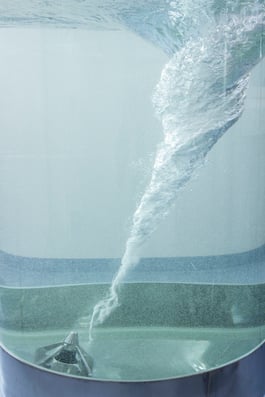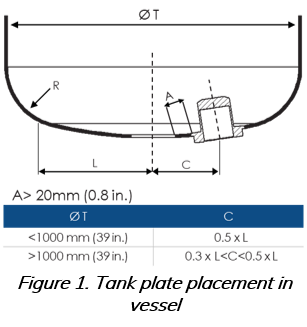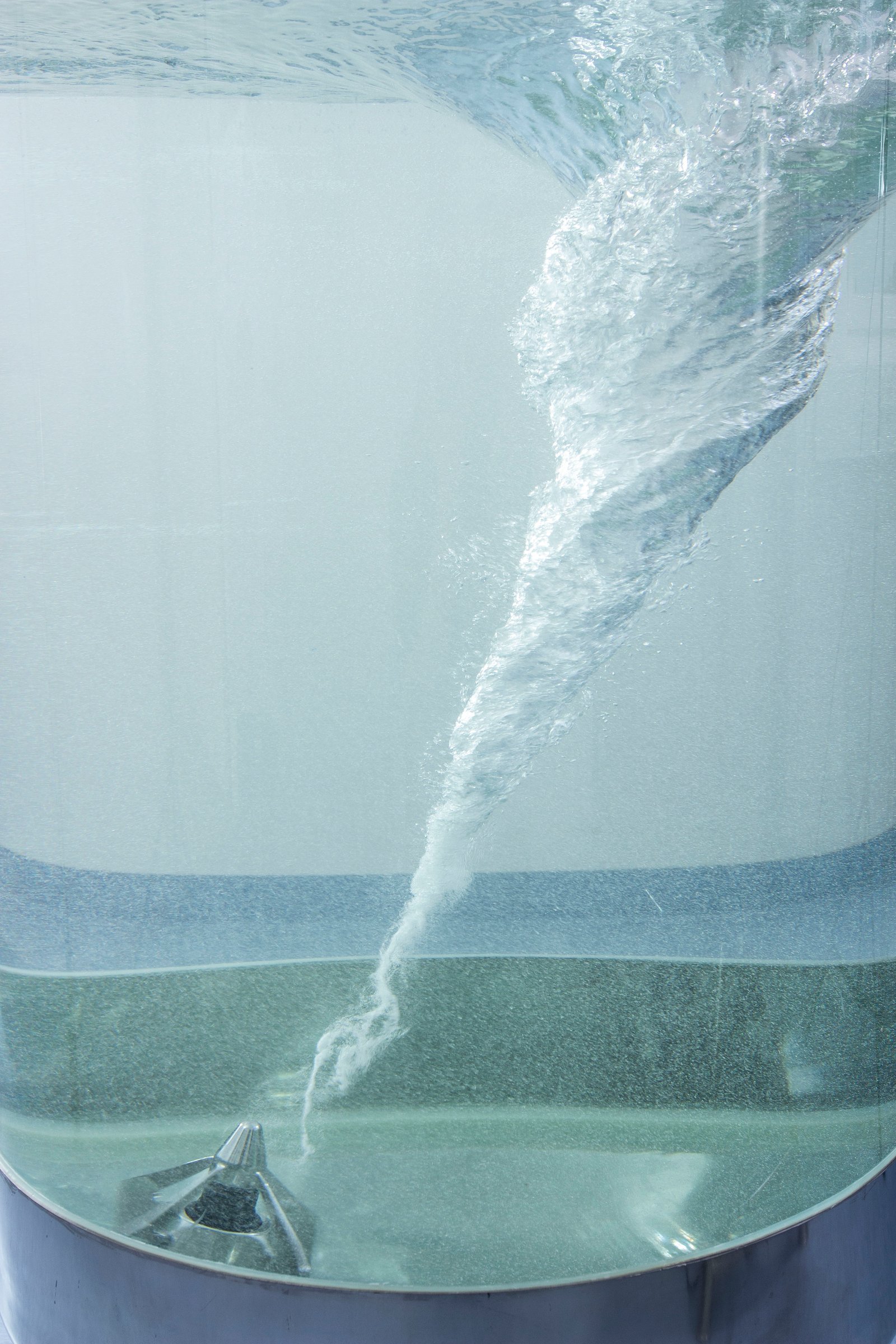Metenova Academy is a series of articles, aiming to introduce and educate in the world of magnetic mixers. We have previously touched upon the alignment between manway access point and mixer tank plate, and in this article, we will focus on vortex.
Vortex, what is it? A vortex is defined as “a mass of fluid with a whirling or circular motion that tends to form a cavity or vacuum in the center of the circle and to draw toward this cavity or vacuum bodies subject to its action”. The preconditions for creating a vortex are the off-center position and the ratio between liquid height and vessel diameter.
When is a vortex desirable?
 Sometimes a vortex is necessary to achieve the desired process result, e.g., when incorporation solids that easily clumps and floating liquids or solids. In many other applications, a vortex is unnecessary and sometimes it should be avoided altogether as it draws down excessive amounts of air that is particularly unfavorable for products who tend to foam.
Sometimes a vortex is necessary to achieve the desired process result, e.g., when incorporation solids that easily clumps and floating liquids or solids. In many other applications, a vortex is unnecessary and sometimes it should be avoided altogether as it draws down excessive amounts of air that is particularly unfavorable for products who tend to foam.
There is a common belief that vortex equals good mixing. This is not the case. A vortex looks powerful, but in fact it is an ineffective way of mixing. The swirling flow pattern of a deep vortex takes longer time to incorporate the different components of the product than a vessel without vortex. And in the end, good mixing is simply mixing customized to a particular application.
If a vortex is needed, what to consider
Vessel design
 By designing the vessel in a certain way, you can either achieve or avoid vortex. The ratio between liquid height and internal diameter to have vortex conditions with off center bottom mounted mixers is between 1:1 and 2:1 [height : diameter] with the most optimal ratio around 1,4:1. Depending on the vessel bottom geometry, the placement of the mixer affects the mixing result. In a dished bottom, the optimal placement to create the most favorable flow is according to figure 1, in the middle of the half radius. If placed closer to the middle, a vortex will be enhanced and if placed closer to the wall, the vortex will have harder to form.
By designing the vessel in a certain way, you can either achieve or avoid vortex. The ratio between liquid height and internal diameter to have vortex conditions with off center bottom mounted mixers is between 1:1 and 2:1 [height : diameter] with the most optimal ratio around 1,4:1. Depending on the vessel bottom geometry, the placement of the mixer affects the mixing result. In a dished bottom, the optimal placement to create the most favorable flow is according to figure 1, in the middle of the half radius. If placed closer to the middle, a vortex will be enhanced and if placed closer to the wall, the vortex will have harder to form.
Inside the vessel there might be other equipment that needs to be considered, for example multiple mixers and vortex breakers for the outlet valve.
Process design
These conditions made by the vessel design creates The Vortex Window. A common misconception is that the mixer is the driving factor in the creation of a vortex, when in fact it is a very small factor. The driving factor is the ratio between height and diameter, and therefore it is important to understand vortex to achieve process control. If the vessel is designed for vortex at full batch size, the vortex window will be located at that liquid level and unachievable at for example ¼ batch.
It is important to understand what the process looks like and at what stages of the process is it crucial to achieve a vortex, e.g. when introducing floating powders and liquids. Thereafter the vessel can be designed according to the process requirement.
 Truelev For low shear applications
Truelev For low shear applications
 Truelev Mobile For shear-sensitive mixing in mobile vessels
Truelev Mobile For shear-sensitive mixing in mobile vessels
 Zero-g For general mixing applications
Zero-g For general mixing applications
 Zero-g Biomixer For gentle mixing in bioreactors
Zero-g Biomixer For gentle mixing in bioreactors
 Zero-g Plastic For chemical applications
Zero-g Plastic For chemical applications
 High Shear For emulsification and high shear applications
High Shear For emulsification and high shear applications
 High Power For powder and vigorous mixing applications
High Power For powder and vigorous mixing applications
 Retrofit your Mixer Replace your existing mixer with a state-of-the-art Metenova mixer.
Retrofit your Mixer Replace your existing mixer with a state-of-the-art Metenova mixer.

 Truelev For low shear applications
Truelev For low shear applications
 Truelev Mobile For shear-sensitive mixing in mobile vessels
Truelev Mobile For shear-sensitive mixing in mobile vessels
 Zero-g For general mixing applications
Zero-g For general mixing applications
 Zero-g Biomixer For gentle mixing in bioreactors
Zero-g Biomixer For gentle mixing in bioreactors
 Zero-g Plastic For chemical applications
Zero-g Plastic For chemical applications
 High Shear For emulsification and high shear applications
High Shear For emulsification and high shear applications
 High Power For powder and vigorous mixing applications
High Power For powder and vigorous mixing applications
 Retrofit your Mixer Replace your existing mixer with a state-of-the-art Metenova mixer.
Retrofit your Mixer Replace your existing mixer with a state-of-the-art Metenova mixer.


 Sometimes a vortex is necessary to achieve the desired process result, e.g., when incorporation solids that easily clumps and floating liquids or solids. In many other applications, a vortex is unnecessary and sometimes it should be avoided altogether as it draws down excessive amounts of air that is particularly unfavorabl
Sometimes a vortex is necessary to achieve the desired process result, e.g., when incorporation solids that easily clumps and floating liquids or solids. In many other applications, a vortex is unnecessary and sometimes it should be avoided altogether as it draws down excessive amounts of air that is particularly unfavorabl By designing the vessel in a certain way, you can either achieve or avoid vortex. The ratio between liquid height and internal diameter to have vortex conditions with off center bottom mounted mixers is between 1:1 and 2:1 [height : diameter] with the most optimal ratio around 1,4:1. Depending on the vessel bottom geometry, the placement of
By designing the vessel in a certain way, you can either achieve or avoid vortex. The ratio between liquid height and internal diameter to have vortex conditions with off center bottom mounted mixers is between 1:1 and 2:1 [height : diameter] with the most optimal ratio around 1,4:1. Depending on the vessel bottom geometry, the placement of 

